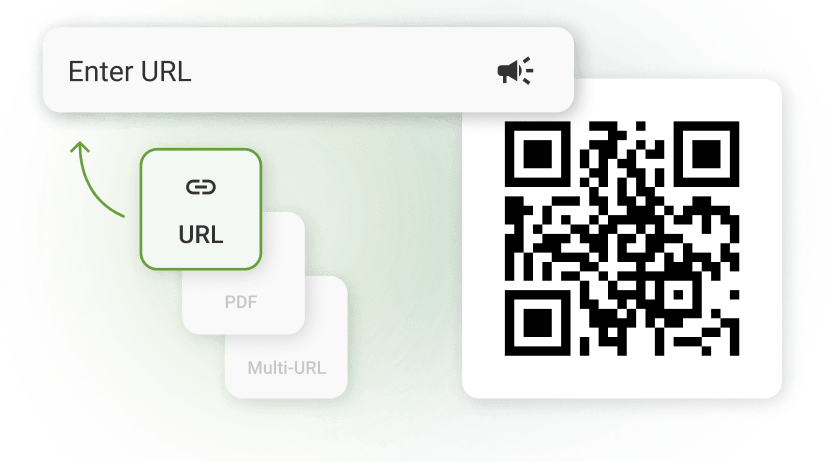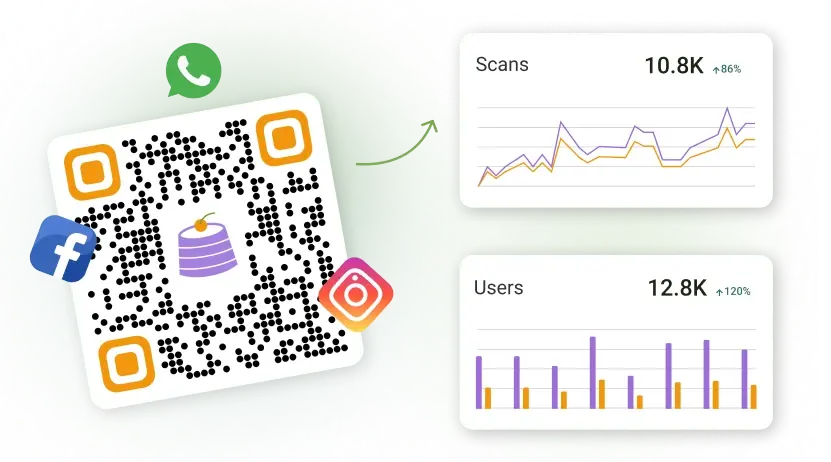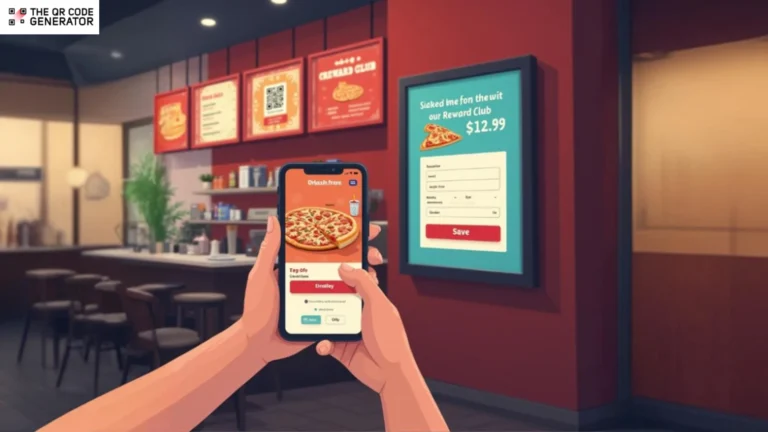Menus are the heart of a restaurant, but designing and printing them isn’t cheap. A single round of designing can cost thousands of dollars.
Now, imagine doing that every season or every time you update a price or swap out a dish. Costs stack up fast. Even small changes or misprints often mean reprinting the entire menu, wasting both money and time.
But there’s a smarter way. With QR Codes on digital menu boards, you can update prices, dishes, or specials instantly—no reprints, no delays, no hassle.
Before we dive into how to set up a restaurant QR Code for your digital menu board, let’s explore how much printed menus are costing us.
Table of contents
- How do printed menus hold your restaurants back?
- How do QR Codes on digital menu boards save money and improve your guests’ experience?
- The easiest way to build a digital menu board with QR Codes
- Proven ways to get better performance from QR Code menu boards
- Save time and money with digital board menus using TQRCG
- Frequently asked questions
How do printed menus hold your restaurants back?
While paper menus may seem harmless, they come with problems that quietly pile up. Let’s break down what sticking to physical menus is costing your restaurant.
1. Static menus don’t give you any flexibility
Once your menu is printed, you’re locked in. You’ll need a fresh print cycle if you change prices, run out of an item, or want to promote a special. Other than design, which costs thousands of dollars and takes time, paper is expensive, too, which, when you think about it, is a lot of trouble for something that could be accomplished quickly and digitally at a lower price.
2. Staff spend too much time managing paper
Managing paper menus isn’t just about printing. Your team has to proof content, deal with vendors, and physically replace menus. Those hours could be better spent with guests, especially during busy service windows.
3. You miss real-time chances to promote or upsell
Static menus show the same thing to every guest, every time. That means you miss out on highlighting your high-margin dishes, time-limited offers, or combo upgrades when they matter most. It’s a missed revenue opportunity that digital menus solve instantly. In fact, drive-thru locations that use digital menu boards experience a 15% to 20% increase in upselling success.
4. Paper menus create waste and hurt your sustainability goals
Menu printing, replacements due to spills, wear, or updates, accounts for 6% to 40% of all paper waste generated in hospitality.
Restaurants throw away thousands of paper menus every year. Whether it’s due to spills, updates, or wear and tear, the result is the same: more waste and higher costs. And in today’s eco-conscious world, guests notice.
Let’s now look at how digital menu boards with QR Codes take these problems off your plate and save you time and money.
How do QR Codes on digital menu boards save money and improve your guests’ experience?
Running a restaurant means things change all the time. Ingredients run out, menus get updated, or you may be short on staff. Even then, your menu needs to stay straightforward and convenient for customers. QR Codes on digital boards make this happen, unlike paper menus that quickly go out of date.
Let’s look at what actually changes when you integrate QR Codes into your digital menu setup.
1. Instant menu updates without the printing hassle
Managing items going unavailable in real time is one of the most complex parts of running a restaurant. When your menu is printed, you can’t update it the moment you run out of something. But with a QR Code pointing to a live digital board menu, you can reflect changes instantly, even from your phone.
Why it matters: You avoid that awkward moment when a guest orders the steak you ran out of an hour ago.
What it solves: If your POS and QR Code menu sync, your staff never has to “go check with the kitchen” again.
Smart move: Use a dynamic QR Code dashboard to swap out links on the fly; there is no need to reprint or reprogram your board.
What are dynamic QR Codes?
Dynamic QR Codes are editable QR Codes that let you change the destination URL without reprinting the code. This means you can update your menu, link, or offer anytime.
With The QR Code Generator (TQRCG), you can create dynamic QR Codes that support unlimited updates and scan tracking, all from one dashboard.
2. A better way to reduce paper waste
Paper menus rarely last long. Once they’re outdated, they go straight to the trash. But with digital QR Code menus, there’s nothing to toss.
Why it matters: You’re saving tons of paper and, hence, being a responsible business owner. That’s good for the planet and your brand’s eco-conscious image.
What it solves: Think of a café that updates its seasonal specials every two weeks. Without QR Code menus, they’d throw away stacks of old menus each time. With digital menus, all updates happen online, without reprints or waste.
Smart move: Keep a running tally of your “paper saved” and share it with guests. It’s a great way to show off your sustainable choices and even market them!
3. More chances to upsell in real time
Printed menus can’t highlight your lunch deal at noon or a dessert combo at dinner. But QR Code-powered digital menu boards can.
Why it matters: You can spotlight high-margin items at just the right moment, which boosts your average order value.
What it solves: Imagine a diner who scans your QR Code menu at 8 PM. They would miss the sale if your printed menu doesn’t show your late-night appetizer deal. With a digital QR Code menu, that promo pops up instantly and drives the order.
Smart move: With a powerful tool such as TQRCG, you can schedule different menu views based on time. For example, you could set your lunch promos to go live at 11 AM and your happy hour deals to go live at 5 PM.
4. Smarter menus with actionable insights
With printed menus, you’re flying blind. You don’t know which sections guests look at, what they skip, or how many actually see your specials. But with QR Codes on digital menu boards, you can start collecting simple but powerful data.
Why it matters: Data lets you stop guessing. You can decide based on what guests scan, click, or spend on, not just what you think works. For example, if a café sees that most scans lead to the sandwich section but hardly anyone clicks on soups, the owner instantly knows where to improve or push daily specials.
What it solves: You can A/B test your menu order (e.g., starters first vs. mains first), highlight an underperforming dish, or promote more profitable combos.
Smart move: Use TQRCG to tag your QR Code links with UTM parameters such as utm_source=menu_board_lunch to track behavior across formats and times. You can integrate and track the links in Google Analytics to gather more detailed insights.
5. Staff can focus on service, not menus
When things get busy, your newest hire shouldn’t have to memorize every dish’s ingredients or allergen information. QR-powered digital menus help guests with the answers they need, helping staff focus on service, not second-guessing.
Why it matters: It reduces training load, avoids mid-service mistakes, and gives new staff a safety net.
What it solves: Guests with special dietary needs get the information they need without putting pressure on your newest hire.
Smart move: Add a second QR Code backstage in the kitchen display, linking to internal SOPs or a “menu 101” doc so staff can scan and refresh anytime.
Now that you know why you must invest in a QR Code menu, you must also know that it’s not that big of an investment either. Let’s see how.
The easiest way to build a digital menu board with QR Codes
You don’t need to be tech-savvy or hire an agency to switch to QR Code-powered digital menus. With the correct setup, you can go from paper-based to paperless in less time than it takes to design a traditional print menu.
Here’s a step-by-step guide to creating QR Codes on digital menu boards:
Step 1: Define your goal
Before you do anything, clarify your goal for what you want your QR Code to accomplish. Are you trying to reduce printing costs, make it easier to update specials, or improve upsell conversions? When you define your goal, the rest of your setup becomes more intentional and effective.
Example: If you want to push lunch specials, your QR Code must link to a time-sensitive menu that updates by daypart.
Step 2: Pick your placement and format
Think about where your guests naturally pause. Usually, they’re in the entryways, the hostess stand, or near the counter. Those spots are ideal for placing your digital menu board. Then, create a dynamic QR Code using The QR Code Generator (TQRCG) to update it anytime without reprinting or changing your display.
Step 3: Select a QR Code platform
Log in to a platform like The QR Code Generator and create your QR Code. Paste your menu link (or upload your PDF/landing page), then choose the QR Code type (URL, multi-URL for dayparts, or even image-based menus).

Next, customize the look: add your restaurant logo, pick colors that match your branding, and choose a frame with a call-to-action like “Scan for Menu.” The dashboard lets you preview your QR Code instantly so you know exactly how it will appear on your board before you go live.
Step 4: Write a CTA that actually works
Generic CTAs like “Scan Me” don’t always move people. Use language that tells guests exactly what they’ll get.
Better options include:
- “Scan to view today’s menu and specials.”
- “Check the latest prices and items here.”
- “Tap to browse and order contact-free.”
This kind of clarity increases scan rates and improves the guest experience.
Step 5: Choose between static and dynamic
Static QR Codes are okay if your menu never changes, but that’s rarely the case. Dynamic QR Codes let you edit your content, redirect your links, and see scan activity without touching your signage.
TQRCG tip: Dynamic QR Codes are free to create and never expire. They’re ideal for restaurants that want control without extra effort. Get access to a 14-day free trial with QR Codes that never expire!
Step 6: Launch, test, and track
Once your QR Code is live, give it a quick scan from different devices to ensure it works. After that, you can use TQRCG’s analytics dashboard to track how many people scan, when they scan, and which boards perform best. This helps you understand what’s working and where to tweak.

Now that your QR Code-powered menu board is up and running, it’s time to ensure that it performs as you expect it to. In the next section, we’ll walk through real-world best practices that help restaurants turn digital menus into reliable tools for cost savings, smoother service, and better guest engagement.
Proven ways to get better performance from QR Code menu boards
Many restaurants struggle not because QR Code menus don’t work, but because they miss small details that make a big difference.
Here’s a quick glossary of must-know terms before we get into best practices:
UTM parameters: Extra tags added to URLs to track where scans come from and what’s working.
Content management system (CMS): The software you use to control what shows up on your digital menu boards.
Quiet zone: Blank space around a QR Code that helps it scan properly.
Offline redirect: A backup page or file that loads if the guest’s device isn’t online.
URL parameters (like ?lang=es): Small add-ons to a link that show content in different languages.
Heatmap reporting: A tool that shows which parts of your menu get the most QR Code scans.
The following best practices come straight from what’s worked for restaurants in live environments. From keeping QR Codes always scannable to optimizing for language, layout, and even Wi-Fi failures, here’s what separates a polished digital setup from a frustrating one.
1. Persistent QR Code overlay and slide lock
If your QR Code rotates with the slide deck, guests might miss it. That’s a common issue with looped promotions. You don’t want them waiting for a code to reappear while their food gets cold.
What to do: In your digital signage CMS, pin the QR Code as a fixed layer in your board’s template. That way, even if the content behind it changes, the code always stays visible and ready to scan.
2. Offline-ready fallback URLs
Restaurant Wi-Fi isn’t always perfect. Guests are stuck and likely annoyed if your internet drops and your QR Code menu goes offline.
What to do: Upload a lightweight HTML or PDF backup version of your menu to your TQRCG dashboard. Set it as your fallback URL so it loads even when connectivity fails. Guests won’t notice the switch, but they’ll appreciate the uninterrupted access.
3. Template-based quiet-zone enforcement
QR Codes need breathing room. If you crowd the code with text, images, or design clutter, phones struggle to scan it.
What to do: Build your menu board template with at least 20% clear space around the code. Run a quick phone scan test each week under your restaurant’s lighting conditions to confirm it scans smoothly.
5. Item-level scan tracking
Scan counts tell you something. But they don’t show what guests are actually interested in or where they drop off. You need more precision to improve your menu strategy.
What to do: Add UTM parameters to each QR Code URL like utm_menu=appetizers. Use this data in Google Analytics or your BI tool to see what’s getting the most attention and what’s not. This helps you fine-tune layout, pricing, or even the dishes you feature.
Want to go deeper? TQRCG lets you run A/B tests so you can compare different menu layouts, highlight specials in two ways, or even test different calls to action. For example, you could see if “Try our chef’s special” drives more clicks than “Limited-time dish.”
With advanced QR Code tracking, you can segment results by time of day or location and spot trends across multiple screens.
Start your first A/B test with TQRCG today and see what truly makes your guests order more.
Save time and money with digital board menus using TQRCG
Running a restaurant means every bit of waste hurts, and menu printing is one of the biggest culprits. Seasonal updates, daily specials, or even a small price change can quietly drain your budget and your time.
Switching to QR Codes on digital menu boards does more than modernize your setup. It helps you cut costs, reduce paper waste, and keep guests happy—without disrupting your workflow.
Ready to shrink your menu-printing budget? Launch your first dynamic QR Code campaign with The QR Code Generator today and start saving where it matters most.
Frequently asked questions
Static QR Codes always point to the same content and can’t be edited once created. Dynamic QR Codes let you update the destination URL anytime without changing the code itself, which makes them ideal for menus that change frequently.
Costs vary widely, but basic digital menu boards typically cost around $300–$500 per screen. Depending on your setup, more advanced systems with touch functionality or POS integration can cost much more.
You can track savings by comparing your previous menu printing and design costs with your current digital setup. QR Code analytics also help you see engagement rates and test what works best to drive sales.
Yes, if designed properly. Accessible QR Code menus should be mobile-friendly, screen-reader compatible, and offer adjustable text sizes or language toggles to support diverse guest needs.
Platforms such as TQRCG have features like HTTPS encryption, link expiration controls, and dashboard-based URL management. They also offer additional security measures like single sign-on, multi-factor authentication, and anomalous scan detection to further ensure your QR Codes stay safe, up-to-date, and protected from tampering.







